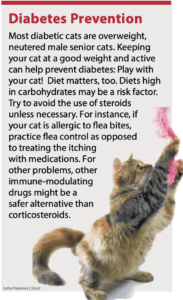Temporary Diabetes
Cats on high levels of steroids or battling pancreatitis may develop temporary secondary diabetes. Weaning off the steroids and healing the pancreatitis may lead to long term remission of the diabetes, and in some cases, it may never recur.
 We used to believe diabetes mellitus was a lifelong disease. Now veterinarians are seeing signs of the disease disappear in some cats, sometimes evolving into remission.
We used to believe diabetes mellitus was a lifelong disease. Now veterinarians are seeing signs of the disease disappear in some cats, sometimes evolving into remission.
“The percentage of cats entering diabetic remission is highly variable and is thought to depend on the underlying cause that precipitated diabetes mellitus, the ability to remove factors that contributed to insulin resistance, and the chronicity of hyperglycemia,” says Dr. Jennifer Prieto, assistant clinical professor of internal medicine at the College of Veterinary Medicine at Cornell University.
True remission is when your cat has had normal blood glucose levels without insulin or an oral medication for at least two weeks, although four weeks is preferred before calling it remission. Most cats who go into remission do so within a few months of starting treatment, although some can take up to a year or more. The use of long-acting insulin products such as glargine has been associated with a greater likelihood of remission.
“Sometimes cats have concurrent diseases, such as hypersomatotropism (acromegaly), that cause insulin resistance and cannot be effectively treated due to limited availability of treatment options (cost, geographic location). Hyperglycemia can damage the cells in the pancreas that produce insulin and therefore diabetic cats can lose the ability to make enough insulin to effectively regulate their blood sugar,” says Dr. Prieto.
Achieving Remission
Cats who are diagnosed early in their disease and who get blood sugar levels controlled within six months tend to have a better prognosis for remission. That means careful monitoring at home with blood level checks via an ear vein or foot pad prick and strict scheduling for the cat’s meals.
Most diabetic cats do best on a primarily canned diet, and offering meals rather than free feeding is important. Low-carbohydrate, high-protein diets are easiest for regulating these cats. Cats showing diabetic neuropathy such as weakness in the rear end have a lower likelihood of going into remission.
Overweight cats should be put on a careful, gradual, weight-loss program and then maintain that new, ideal weight. Any medications that influence insulin usage, including corticosteroids such as prednisone, dexamethasone, and depo medrol, should be stopped, if possible.
Cats with other ongoing health problems are less likely to go into remission. The inability to maintain a lean body condition, the use of medications that promote insulin resistance, and ongoing concurrent diseases contribute to relapse from remission, says Dr. Prieto.
The American Association of Feline Practitioners warns that “even cats that are in remission may fail a glucose tolerance test: Once a diabetic, always a diabetic, always at risk for recurrent insulin dependence.”
Relapses Happen
Relapse is common, with 26 to 30% of cats becoming insulin-dependent again after  remission. Some studies estimate median remission times of 120 to 150 days, although that’s highly variable and can range from several weeks to many years. You will need to be observant so that you can immediately notice if your cat goes out of remission. She will show the same signs as prior to her original diagnosis, which include weight loss, increased appetite, and increased water intake and urination.
remission. Some studies estimate median remission times of 120 to 150 days, although that’s highly variable and can range from several weeks to many years. You will need to be observant so that you can immediately notice if your cat goes out of remission. She will show the same signs as prior to her original diagnosis, which include weight loss, increased appetite, and increased water intake and urination.
Cats that enter remission may remain in a pre-diabetic state and have higher-than-normal blood glucose levels when at rest or challenged with a meal and have fewer pancreatic beta-cells to make insulin. Over time, they often exhaust these cells and lose the ability to regulate their blood glucose.
Bottom Line
The idea of remission brings hope, but it’s important to be realistic. If your diabetic cat goes into remission, she may experience episodes of hypoglycemia and show signs such as weakness if you continue to administer insulin. If this happens, you need to consult with your veterinarian immediately and schedule a visit to recheck her blood values to determine if she truly is in remission.ν
New Diabetes Treatment
The FDA recently approved an oral drug called bexagliflozin (Bexacat) for the treatment of newly diagnosed feline diabetics that have not received insulin therapy. Talk to your veterinarian about this exciting new development.
Diabetes Prevention
Most diabetic cats are overweight, neutered male senior cats. Keeping your cat at a good weight and active can help prevent diabetes: Play with your cat! Diet matters, too. Diets high in carbohydrates may be a risk factor. Try to avoid the use of steroids unless necessary. For instance, if your cat is allergic to flea bites, practice flea control as opposed to treating the itching with medications. For other problems, other immune-modulating drugs might be a safer alternative than corticosteroids.
Jennifer Prieto, DVM, PhD, is an assistant clinical professor in the section of small animal medicine at Cornell University’s College of Veterinary Medicine.



